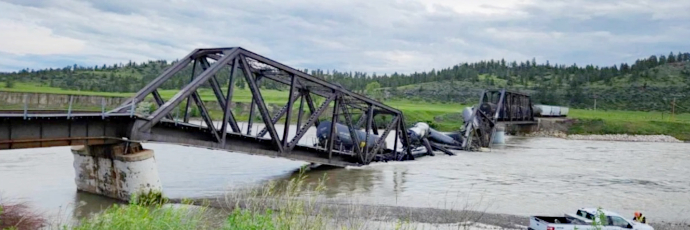A freight train carrying hazardous materials derailed on a bridge in Stillwater County, Montana on June 25, 2023. Photo by Montana Fish, Wildlife and Parks Department.
The Stillwater County, Montana sheriff’s office said it was a “great stroke of luck” that none of the train cars were carrying oil that would have polluted the Yellowstone River.
Montana train wreck raises fears of similar disasters on proposed Uinta Basin Railway
by Julia Conley — Common Dreams
A freight train derailment and the collapse of a bridge over the Yellowstone River in Montana on Saturday raised alarm as several cars carrying asphalt and molten sulfur tumbled into the river, prompting officials to take emergency measures at nearby water plants.
The incident also brought to mind for some critics the Biden administration’s plan to move forward with a railway project along the Colorado River—one that could place the drinking water of 40 million people at risk as trains transport crude oil from eastern Utah’s Uinta Basin to national rail lines.
The substances solidified quickly once exposed to the cold water in the Yellowstone River on Saturday, and Stillwater County emergency services chief David Stamey told The New York Times that the solidification could limit the potential harmful effects to the environment.
Sulfur is commonly used as an insecticide, fungicide, and rodenticide, and is often used in fertilizers.
As a precaution, water treatment plant officials in Yellowstone and Stillwater Counties temporarily shut down water intake until the material had flowed past Billings, which lies about an hour’s drive east of the derailment site. Authorities also asked residents to conserve water. About 167,000 people live in Yellowstone County while roughly 9,000 people live in Stillwater.
The freight train was operated by Montana Rail Link, whose spokesperson told the Times that two cars were also carrying sodium hydro sulfate, which can cause serious eye damage on exposure.
“Neither of these cars have entered the water and initial air quality assessments have been performed and confirmed that there is no release associated with the two cars,” the railroad said in a statement.
Ten cars in total derailed, the Times reported.
Montana Rail Link said no one was injured in the accident.
Robert Bea, a retired engineering professor at the University of California Berkeley, told the Associated Press that recent heavy rains may have played a role in the collapse of the bridge.
“The high water flow translates to high forces acting directly on the pier and, importantly, on the river bottom,” Bea told the outlet. “You can have erosion or scour that removes support from the foundation. High forces translate to a high likelihood of a structural or foundation failure that could act as a trigger to initiate the accident.”
The cause of the derailment and collapse are being investigated.
To Ted Zukoski, a senior attorney in the Center for Biological Diversity’s public lands program, the accident raised concerns about similar potential disasters along the Uinta Basin Railway, which could carry as many as five two-mile-long crude oil trains more than 100 miles each day alongside the Colorado River’s headwaters each day.
“For about 100 miles of the railroad, it is close enough to the river that if you’re sitting in a raft in the middle of it, you could throw a rock and hit the railroad, Zukoski told Lever News last month.
As Democratic Senators Michael Bennet and John Hickenlooper and Representative Joe Neguse, all of Colorado, told US Transportation Secretary Pete Buttigieg in a letter earlier this year urging him to oppose the project, the public-private alliance behind the Uinta Basin Railway appears to have “no plan to mitigate the harm of a potential accident or derailment in Colorado, which could be particularly difficult to address given our state’s mountainous terrain.”
In addition to worsening the climate crisis by supporting the increased production of 350,000 barrels of oil per day, the Utah Clean Infrastructure Coalition has said in a fact sheet on the project, “the heavy, long oil tanker trains used to transport crude oil pose greater risks of derailment and spills than other freight trains, and an increased risk of fire due to derailment and spilling of combustible oil.”
In Montana on Saturday, the Stillwater County Sheriff’s office said it was a “great stroke of luck” that none of the train cars were carrying oil that would have polluted the Yellowstone.
Contact us by email at fund4thepanamanews@gmail.com
To fend off hackers, organized trolls and other online vandalism, our website comments feature is switched off. Instead, come to our Facebook page to join in the discussion.
These links are interactive — click on the boxes












